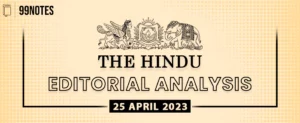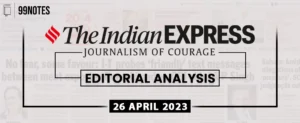27 April 2024 : Daily Current Affairs
Daily Current Affairs
27-April -2024- Top News of the Day
1. SC seeks EC reply on petition for fresh poll if NOTA gets most votes
| (Source – The Hindu, Section – News, Page – 3)
Topic: GS2 – Indian Polity The topic highlights electoral reforms, judicial intervention, and the significance of NOTA, relevant for UPSC’s governance and political science syllabus. |
| Context: |
| ● The Supreme Court is reviewing a plea regarding constituencies where NOTA wins, potentially barring candidates with fewer votes from future elections. |
Analysis of news:
- The Supreme Court has asked the Election Commission (EC) to respond to a plea regarding constituencies where NOTA (none of the above) wins majority votes.
- The petition urges the court to direct the EC to establish rules stating that candidates receiving fewer votes than NOTA should be barred from contesting elections for five years.
- NOTA was introduced by the EC and various State Election Commissions in November 2013.
- Some states like Maharashtra, Haryana, Delhi, and Puducherry have treated NOTA as a “fictional electoral candidate” since 2018.
- These states declared that if NOTA wins, there should be a mandatory re-poll, as declaring the second highest candidate as the winner violates the purpose of NOTA.
- The petition argues for uniform application of these rules across the country.
| More About ‘NOTA’ (None of the Above) |
| ● Introduction: NOTA, or None of the Above, is an electoral option available to voters in India since 2013, allowing them to reject all candidates contesting in an election.
● Purpose: NOTA provides voters with the option to express their dissatisfaction with the listed candidates and the electoral process itself. ● Symbol: NOTA is represented by a symbol on the Electronic Voting Machine (EVM) and appears as a separate option on the ballot paper. ● Legal Status: The Supreme Court of India recognized the right to NOTA as a fundamental right of voters in the landmark judgement of People’s Union for Civil Liberties v. Union of India in 2013. ● Effect: Votes cast for NOTA are counted separately from the total votes polled, and if NOTA receives the highest number of votes, the candidate with the next-highest number of votes is declared the winner. ● Limitations: NOTA does not directly affect the outcome of elections, as the candidate with the highest number of valid votes is still declared the winner, regardless of the NOTA votes. ● Awareness: Despite being available as an option, awareness and utilisation of NOTA among voters remain relatively low. ● Criticism: Critics argue that NOTA lacks teeth as it does not lead to the rejection of candidates or necessitate a re-election, limiting its effectiveness in promoting accountability and electoral reforms. |
| Practice Question: Discuss the significance of the ‘NOTA’ (None of the Above) option in India’s electoral system. Assess its impact on electoral transparency and accountability, and propose potential reforms. (150 Words /10 marks) |
2. Study says solar radiation available for producing power falling in India
| (Source – The Hindu, Section – News, Page – 5)
Topic: GS1 – Geography – Effects of Climate change, GS3 – Environment The topic sheds light on India’s renewable energy goals, environmental challenges, and technological solutions, relevant for UPSC’s environmental science syllabus. |
| Context: |
| ● The news discusses a study by IMD scientists revealing a concerning decline in economically convertible solar radiation in India, attributed to increased aerosol load and clouding. |
Analysis of news:
- India Meteorological Department (IMD) scientists report an alarming decrease in economically convertible solar radiation in several Indian locations.
- Increased aerosol load and clouding are cited as causative factors.
- Efficient solar panel installation is suggested to counteract the trend.
- Aerosols absorb sunlight and deflect it away, while also contributing to cloud formation that further blocks sunlight.
- The study analysed solar photovoltaic (SPV) potential at 13 stations from 1985 to 2019.
- SPV potential decline was observed across all stations, including major cities like Ahmedabad, Mumbai, and New Delhi.
- Despite India’s ambitious plans to source 500 GW of electricity from non-fossil fuel sources by 2030, solar capacity addition has been sluggish.
- Prime Minister announced funding for rooftop solar installations in one crore houses.
- Studies show variations in aerosol impact on sunlight over time and location, with global solar radiation trends exhibiting fluctuations since the 1980s.
| Potential impact of this report |
| ● Energy Security: The decline in convertible solar radiation threatens India’s goal of sourcing a significant portion of its electricity from solar power.
● Economic Implications: Reduced solar radiation efficiency could hinder the growth of the solar energy sector, impacting investments and job creation. ● Environmental Concerns: Dependency on non-renewable energy sources may increase, leading to higher carbon emissions and environmental degradation. ● Technological Innovation: The need for more efficient solar panel technologies becomes imperative to maximise energy conversion despite reduced radiation. ● Policy Reassessment: Government policies and initiatives may need revision to address the challenges posed by declining solar radiation and ensure continued progress towards renewable energy targets. ● Regional Disparities: Areas heavily reliant on solar power, such as Gujarat and Rajasthan, may face disproportionate impacts, affecting local economies and livelihoods. ● Global Perspective: India’s renewable energy commitments contribute to global efforts to combat climate change; any setback in achieving these goals could have broader environmental implications. ● Social Equity: Ensuring equitable access to renewable energy amidst declining solar radiation is crucial to prevent exacerbating socio-economic disparities. ● Adaptation Strategies: Developing resilience measures and diversifying renewable energy sources may be necessary to mitigate the impacts of declining solar radiation. |
| PYQ: India has immense potential for solar energy though there are regional variations in its development. Elaborate. (250 words/15m) (UPSC CSE (M) GS-1 2020) |
| Practice Question: Assess the implications of the reported decline in economically convertible solar radiation in India. Discuss potential strategies to mitigate this trend and achieve the nation’s renewable energy targets. (250 Words /15 marks) |
3. India’s patent filings climbed 24.6% to 83,000 in FY23, shows Nasscom report
| (Source – The Hindu, Section – Business, Page – 11)
Topic: GS3 – Indian economy, GS3 – Science and Technology – Issues relating to IPR The topic underscores India’s growing innovation landscape and emphasis on intellectual property rights, relevant to UPSC’s science and technology syllabus. |
| Context: |
| ● The news highlights a surge in patent filings in India, with 83,000 patents filed in FY2023, marking a 24.6% annual growth, driven by increased focus on intellectual property rights. |
Analysis of news:
- In FY2023, India witnessed a surge in patent filings, totaling 83,000, with a remarkable annual growth rate of 24.6%.
- This growth is the highest recorded in the past two decades, mirroring global trends in innovation and intellectual property.
- The number of patents granted also doubled between FY19-23, indicating a strong momentum in innovation and research.
- Nasscom’s Patenting Trends report predicts a further spike, with over 1,00,000 patents expected to be granted between March 15, 2023, and March 14, 2024.
- Notably, the proportion of patents filed by Indian residents (primary filers based in India) has doubled over the past decade.
- From constituting 33.6% of total filings in FY2019, residents now account for more than 50% of filings in FY2023.
- Nasscom attributes this significant rise to a growing focus on intellectual property rights (IPR) and heightened awareness in the country.
- Educational institutes emerge as key drivers of this growth, indicating a strengthening innovation ecosystem in India.
| Strengthening innovation ecosystem in India |
| Prospects of Strengthening Innovation Ecosystem:
● Economic Growth: A robust innovation ecosystem can drive economic growth by fostering entrepreneurship, creating jobs, and enhancing competitiveness in global markets. ● Technological Advancement: Innovation promotes technological advancement, leading to the development of cutting-edge solutions, products, and services across various sectors. ● Social Impact: Innovation addresses societal challenges and improves quality of life through advancements in healthcare, education, agriculture, and other critical areas. ● Global Recognition: Strengthening the innovation ecosystem enhances India’s reputation as a hub for innovation and attracts investment, collaboration, and partnerships with international stakeholders. ● Youth Empowerment: Encouraging innovation empowers youth, fosters creativity, and nurtures a culture of entrepreneurship and problem-solving among the younger generation. Challenges: ● Infrastructure: Inadequate infrastructure, including research facilities, incubation centres, and funding mechanisms, hinders innovation and entrepreneurship. ● Regulatory Framework: Complex regulatory processes, bureaucratic hurdles, and legal barriers create challenges for startups and innovators in navigating the business environment. ● Access to Funding: Limited access to capital, particularly early-stage funding and venture capital, constrains the growth and scalability of innovative startups and projects. ● Skill Development: Shortage of skilled workforce and talent gaps in science, technology, engineering, and mathematics (STEM) fields pose challenges for innovation-driven industries. ● Intellectual Property Rights: Weak enforcement of intellectual property rights (IPR) and challenges in patenting processes discourage innovation and hinder investment in research and development (R&D). ● Cultural Mindset: Cultural attitudes towards risk-taking, failure, and experimentation need to evolve to foster a conducive environment for innovation and entrepreneurship. ● Collaboration and Ecosystem Connectivity: Limited collaboration and ecosystem connectivity between academia, industry, and government stakeholders impede knowledge sharing, technology transfer, and innovation diffusion. Way Forward: ● Policy Support: Implement supportive policies, incentives, and regulatory reforms to promote innovation, R&D, and entrepreneurship. ● Infrastructure Development: Invest in research infrastructure, technology parks, innovation hubs, and incubation centres to support startups and innovators. ● Access to Funding: Enhance access to funding through government grants, venture capital funds, angel investors, and crowdfunding platforms for innovative projects. ● Skill Enhancement: Strengthen STEM education, vocational training, and skill development programs to nurture talent and meet industry demands. ● IPR Protection: Improve IPR enforcement mechanisms, streamline patenting processes, and provide legal support to protect intellectual property rights. ● Promotion of Collaboration: Foster collaboration between academia, industry, research institutions, and government agencies to facilitate knowledge exchange, technology transfer, and innovation diffusion. ● Entrepreneurial Culture: Promote an entrepreneurial culture by celebrating risk-taking, encouraging experimentation, and providing mentorship and support to aspiring innovators and startups. |
| PYQ: India’s Traditional Knowledge Digital Library (TKDL) which has a database containing formatted information on more than 2 million medicinal formulations is proving a powerful weapon in the country’s fight against erroneous patents. Discuss the pros and cons making this database publicly available under open-source licensing. (200 words/12.5m) (UPSC CSE (M) GS-3 2015) |
| Practice Question: Discuss the significance of the recent surge in patent filings in India and its implications for innovation and economic development. (250 Words /15 marks) |
4. Supreme Court Directs Sealing of Symbol Loading Units (SLUs) for 45 Days Post-Election
| (Source – Indian Express, Section – Explained, Page – 14)
Topic: GS2 – Governance – Government policies – Interventions for development in various sectors This topic is relevant for both Prelims and Mains as the article provides insights into the functioning of India’s electoral process, focusing on the directives issued by the Supreme Court regarding Voter Verifiable Paper Audit Trail (VVPAT) slips and Symbol Loading Units (SLUs). |
| Context: |
|
Analysis of news:
Understanding Symbol Loading Units (SLUs):
- SLUs play a crucial role in the electoral process by loading symbols of candidates onto VVPATs, ensuring accurate representation of voter choices.
- These devices are used shortly before polling to upload candidate symbols onto VVPAT machines, under the supervision of district election officers.
- After this process, SLUs are typically handed over to election officials for safekeeping until the day after voting.
Description and Operation of Symbol Loading Units

- The SLU, a matchbox-sized device, is used for this purpose.
- Initially connected to a laptop or personal computer, the SLU employs a symbol loading application to load a bitmap file containing candidate names, serial numbers, and symbols.
- The SLU is then connected to the VVPAT to transfer the file under the supervision of a district election officer.
Implications of Supreme Court’s Directive:
- The Supreme Court’s directive mandates the sealing and storage of SLUs for 45 days after the declaration of election results, alongside EVMs.
- This implies that SLUs used for loading symbols onto VVPATs for one seat cannot be reused for other seats, necessitating the procurement of additional SLUs by the Election Commission of India (ECI).
- Additionally, the court’s decision to allow candidates to seek verification of EVM software, including microcontrollers, adds a new layer of scrutiny to the electoral process.
Challenges and Changes in Electoral Procedures:
- The inclusion of SLUs for examination and the verification of EVM software pose logistical and administrative challenges for the ECI.
- The need to store SLUs for an extended period and ensure the verification process for candidates finishing second or third requires additional resources and manpower.
- Moreover, the potential amendment of the Representation of the People Act of 1951 may be necessary to accommodate changes in electoral procedures and the handling of EVMs during the verification period.
Impact on Electoral Transparency and Accountability:
- The Supreme Court’s directive and the proposed verification process for EVMs aim to enhance electoral transparency and accountability.
- By allowing candidates to seek verification of EVM software and including SLUs for examination, the court seeks to address concerns regarding the integrity of the electoral process and uphold the principles of free and fair elections.
- However, the practical implementation of these directives will require careful planning and coordination by the ECI to ensure smooth conduct of future elections while maintaining the credibility of the electoral process.
| How is VVPAT used for verification? |
|
| PYQ: In the light of recent controversy regarding the use of Electronic Voting Machines (EVM), what are the challenges before the Election Commission of India to ensure the trustworthiness of elections in India? (150 words/10m) (UPSC CSE (M) GS-2 2018) |
| Practice Question: What is the role of Symbol Loading Units (SLUs) in India’s electoral process? Discuss the significance of SLUs in ensuring the accuracy of printed party symbols on Voter Verifiable Paper Audit Trail (VVPAT) slips. How does the recent directive by the Supreme Court regarding SLUs impact electoral procedures? Evaluate the challenges and changes required to implement this directive effectively. (250 words/15 m) |
5. ISRO’s Satellite Analysis Reveals Significant Expansion of Glacial Lakes in Indian Himalayan Region
| (Source – Indian Express, Section – Explained, Page – 14)
Topic: GS3 – Environment – Environmental Pollution and Degradation GS1 – Geography- Climate change This topic is relevant for both Prelims and Mains in the context of knowing facts about the expansion of glacial lakes in the Indian Himalayan region due to glacier retreat which raises concerns about environmental changes and their impacts on ecosystems and communities downstream. |
| Context: |
|
Analysis of News:
Revelations from ISRO’s Analysis:
- ISRO’s analysis utilized satellite data spanning four decades to assess changes in the glaciated environment of the Indian Himalayan river basins.
- The data revealed significant expansion in the size of glacial lakes, particularly in regions where glaciers are retreating due to global warming.
- Of the identified glacial lakes larger than 10 hectares, a substantial number had expanded significantly since 1984, indicating a growing trend.
Formation of Glacial Lakes:
- Glacial lakes are formed as a result of glacier movement, which creates depressions in the surrounding topography.
- When glaciers retreat, meltwater accumulates in these depressions, giving rise to glacial lakes. ISRO categorized glacial lakes into four main types based on their formation mechanisms, including moraine-dammed, ice-dammed, erosion-based, and others.
Role of Satellite Remote-Sensing Technology:
- Satellite remote-sensing technology plays a crucial role in monitoring glacial lakes, especially in the challenging terrain of the Himalayan region.
- ISRO highlighted the effectiveness of satellite-derived long-term change analysis in understanding glacial lake dynamics and assessing environmental impacts.
- Experts emphasized the importance of remote sensing tools in monitoring the growth of glacial lakes, especially in inaccessible areas.
Mitigation Strategies for Glacial Lake Risks:
- One approach to mitigating the risks posed by glacial lakes involves lowering water levels to reduce the potential impact of GLOFs on downstream communities.
- A study published in 2023 examined the risks posed by Ghepan Gath lake in Himachal Pradesh and modeled the impacts of lowering water levels.
- It found that lowering lake levels by 10 to 30 meters could significantly reduce the risks, though not entirely eliminate them.
- Additionally, techniques such as using long High-Density Polyethylene (HDPE) pipes have been employed to syphon off lake water, as demonstrated in Sikkim’s South Lhonak Lake in 2016.
Conclusion:
- ISRO’s analysis sheds light on the expanding presence of glacial lakes in the Indian Himalayan region and underscores the importance of monitoring and mitigating the risks associated with these water bodies.
- Utilizing satellite technology and implementing mitigation strategies are crucial steps in addressing the potential threats posed by glacial lake outburst floods and safeguarding downstream communities and infrastructure.
| What are Glacial Lakes? |
Categorization: Glacial lakes are classified into four main types based on their formation process:
Expansion Distribution:
Formation Process:
Moraine Formation:
Important Glacial Lakes in India:
|
| PYQ: How will the melting of Himalayan glaciers have a far-reaching impact on the water resources of India? (150 words/10m) (UPSC CSE (M) GS-1 2020) |
| Practice Question: Discuss the significance of ISRO’s recent satellite-based analysis on the expansion of glacial lakes in the Indian Himalayan region. Analyze the environmental implications of glacial lake expansion and the potential risks associated with glacial lake outburst floods (GLOFs) on downstream communities and infrastructure. (250 words/15 m) |
6. India’s Forex Reserves Decline for Second Consecutive Week, Hits $640.334 Billion: RBI Report
| (Source – Indian Express, Section – Economy, Page – 15)
Topic: GS3 – Indian Economy – Effects of liberalization on the economy This topic is relevant for both Prelims and Mains in the context of understanding the dynamics of forex reserves, including the factors influencing their fluctuations and the composition of reserves which is crucial for comprehending India’s economic stability and its ability to withstand external shocks. |
| Context: |
|
Analysis of News:
Factors behind the Decrease:
- The decrease in reserves can be attributed to the central bank’s deployment of the forex kitty to defend the rupee against pressures, primarily stemming from global events.
- Such interventions often require the utilization of forex reserves to stabilize the currency.
Composition of Reserves:
- For the week ended April 19, the foreign currency assets, a significant component of the reserves, saw a decline of $3.793 billion to $560.86 billion.
- These assets are influenced by factors such as the appreciation or depreciation of non-US units like the euro, pound, and yen held in the foreign exchange reserves.
- Meanwhile, gold reserves continued to rise, increasing by $1.01 billion to $56.808 billion during the same week.
Status of Special Drawing Rights (SDRs):
- The Special Drawing Rights (SDRs) witnessed a slight decrease of $43 million to $18.034 billion, according to the RBI’s report. SDRs represent an international reserve asset created by the International Monetary Fund (IMF) and allocated to its member countries as a supplement to existing reserves.
| About Foreign Exchange Reserves: |
|
What is it?
India’s foreign exchange reserves comprise of;
Purpose:
|
| Practice Question: Discuss the recent trends in India’s foreign exchange reserves as reported by the Reserve Bank of India (RBI). Highlight the factors contributing to the fluctuations in reserves and analyze the implications of these trends on India’s economic stability and monetary policy. (250 words/15 m) |
For Enquiry

27 April 2024 : Daily Current Affairs Quiz

27 April 2024 : Daily Answer Writing

27 April 2024 : The Hindu Editorial Notes PDF

27 April 2024 : Daily Current Affairs

27 April 2024 : PIB Summary for UPSC

27 April 2024 : Indian Express Editorial Analysis

26 April 2024 : Daily Current Affairs Quiz

26 April 2024 : Daily Answer Writing

26 April 2024 : The Hindu Editorial Notes PDF

26 April 2024 : PIB Summary for UPSC
Daily Quiz 27 April 2024 : Daily Current Affairs Quiz 27- April 2024 : Daily Quiz…
mains answer writing 27 April 2024 : Daily Answer Writing Mains Answer Writing
27-April-2024
Q1) Describe the functioning of the Public Distribution System (PDS)…
April 2024 The Hindu Editorial 27 April 2024 : The Hindu Editorial Notes PDF The Hindu EDITORIAL
27-April-2024
1. Sounding the gavel on curative jurisdiction
Topic: GS2 – Indian…
April 2024 Daily Current Affairs 27 April 2024 : Daily Current Affairs Daily Current Affairs
27-April -2024- Top News of the Day
1. SC seeks EC reply on petition for fresh…
April 2024 PIB 27 April 2024 : PIB Summary for UPSC PIB Summary for UPSC
27-April-2024
1. SCO Defence Ministers’ Meeting in Kazakhstan endorses ‘One Earth,…
April 2024 Indian Express 27 April 2024 : Indian Express Editorial Analysis Indian Express Editorial Analysis
27-April-2024
1. ROBUST AND TRANSPARENT
Topic: GS2 – Governance…
Daily Quiz 26 April 2024 : Daily Current Affairs Quiz 26- April 2024 : Daily Quiz…
mains answer writing 26 April 2024 : Daily Answer Writing Mains Answer Writing
26-April-2024
Q1) Discuss the multifaceted significance of the fisheries sector…
April 2024 The Hindu Editorial 26 April 2024 : The Hindu Editorial Notes PDF The Hindu EDITORIAL
26-April-2024
1. Questioning the polls ‘rain washes out play’ moments
Topic:…
April 2024 PIB 26 April 2024 : PIB Summary for UPSC PIB Summary for UPSC
26-April-2024
1. Council of Scienific & Industrial Research (CSIR)- National…


